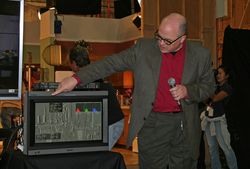Sony Talks Up 3D in L.A.
 At the Culver City studios of Sony Pictures, Sony execs today rolled out their plans for what they hope will be domination of every aspect of the 3D business: movie/TV production, professional gear, and consumer electronics products.
At the Culver City studios of Sony Pictures, Sony execs today rolled out their plans for what they hope will be domination of every aspect of the 3D business: movie/TV production, professional gear, and consumer electronics products.According to Sony Corporation chairman Sir Howard Stringer (pictured below), who began the presentation, the distinction between Sony 3D and 3D from other manufacturers will be one of quality. “Good 3D is immersive, not jarring,” he said as a prelude to a demo of several 3D clips shown on a huge screen illuminated by a digital cinema projector. However, the 3D technology in this demo used passive, polarized 3D glasses of the sort you probably used to watch Avatar in the theater—not the active LCD shutter glasses used with the new 3D TVs.
Stan Glasgow, president/COO of Sony Electronics, then outlined the reasons why Sony feels it can deliver a better 3D experience than other TV makers can:
? A stronger IR transmitter (the device that sends the timing signal to the active 3D glasses), which will allow a wider viewing angle.
? A closed glasses design, which permits fewer distractions from beyond the screen and allows less ambient light to enter.
? Precise LED backlight control for a brighter, clearer picture.
? Lower power consumption than plasma—as much as 2/3rds less on some models.
“Those 3D TVs on the market now cannot stand up to Sonys,” he stated, later adding that, “Sony is the first company to get 3D TV right.”
Of course, only time—and a review in S+V—will tell. Unfortunately, no performance comparisons were offered at the event.
Glasgow said that Sony Bravia 3D TVs are now available for pre-order, and range in size from a 40-inch set for $2,000 to a 60-inch set for $5,000 (including two sets of glasses and an IR transmitter). Sony’s 3D-compatible Blu-ray players will start at $200.
 All Sony Playstation 3 consoles are 3D-capable through a software upgrade—both for 3D games and for 3D Blu-ray Discs. Buyers of the new Bravia 3D TVs will receive a free download of two 3D games, Wipeout HD and Super Stardust, as well as previews of several other new 3D games.
All Sony Playstation 3 consoles are 3D-capable through a software upgrade—both for 3D games and for 3D Blu-ray Discs. Buyers of the new Bravia 3D TVs will receive a free download of two 3D games, Wipeout HD and Super Stardust, as well as previews of several other new 3D games.Afterward, Sony demonstrated some of its 3D production equipment, which it uses to teach a “3D school” for film and video (or should I say movie and TV?) professionals. The best part was a cool 2D monitor (pictured above) showing a black-and-white image used to monitor the depth effect of the 3D without having to wear glasses. It made everything in the image look as if it were embossed on a sheet of aluminum.
—Brent Butterworth
- Log in or register to post comments





























































